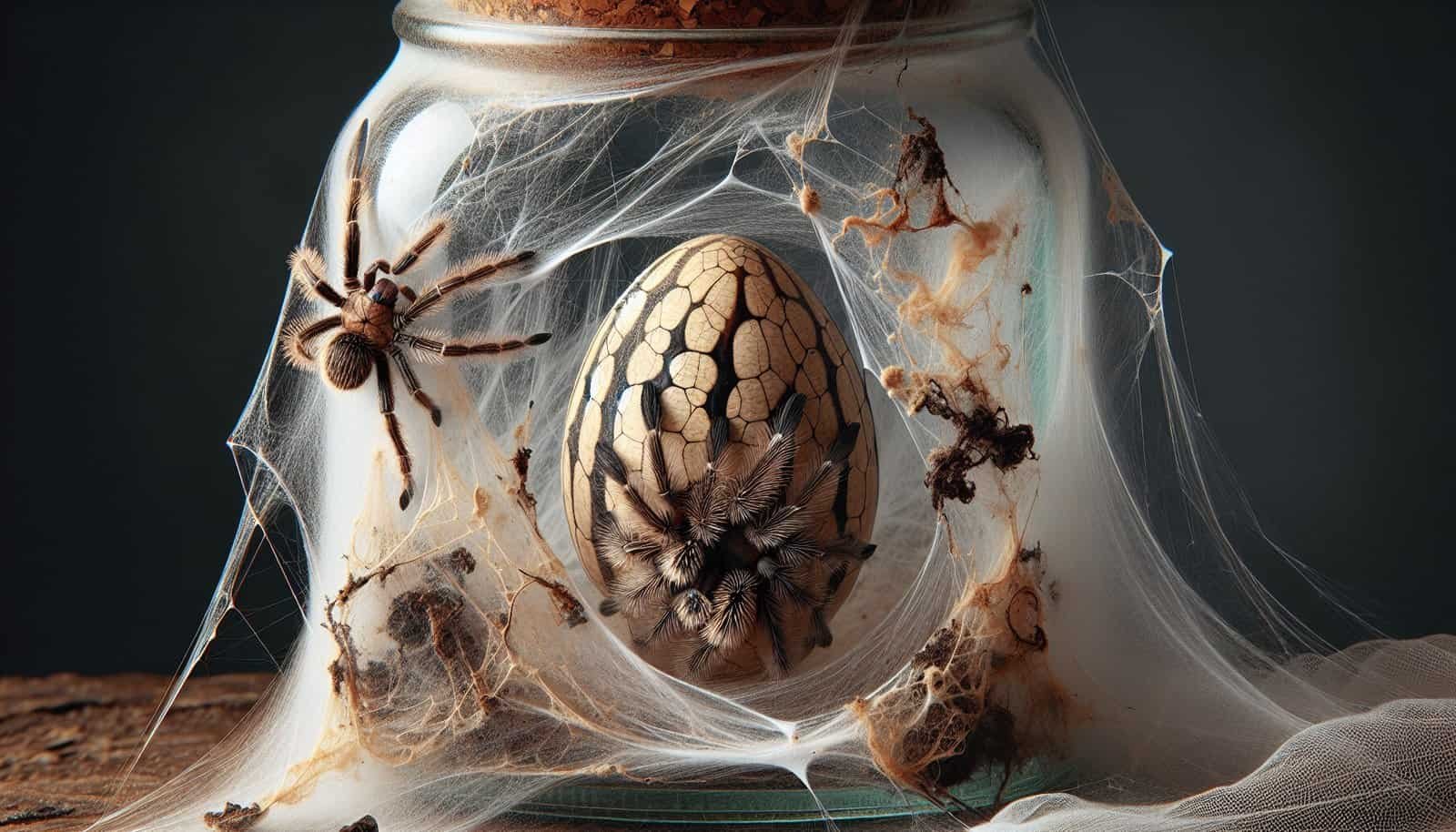So, you’re a proud tarantula owner and you’ve recently noticed something concerning – your tarantula’s eggs are starting to mold. Don’t worry, it’s not uncommon for this to happen and there are steps you can take to address the situation. In this article, we will explore why tarantula eggs can mold and provide you with some practical tips on how to deal with this issue. By following these simple guidelines, you’ll be able to safeguard your tarantula’s eggs and give them the best chance of hatching successfully.
Identifying Mold on Tarantula Eggs
Tarantula egg mold is a common issue that many tarantula keepers may encounter. It is crucial to identify the signs of mold on tarantula eggs promptly in order to take appropriate measures. Mold on tarantula eggs can appear as fuzzy white or greenish patches on the surface of the eggs. These patches may grow in size and spread if left untreated.
Causes of Mold on Tarantula Eggs
Mold on tarantula eggs can occur due to various factors, including poor environmental conditions, improper hygiene, and overcrowding. Excess moisture is a common cause, as it creates a favorable environment for mold growth. If the humidity levels are too high, it can lead to condensation on the egg sac, providing an ideal breeding ground for mold. Similarly, inadequate ventilation and lack of air circulation can contribute to mold growth. Furthermore, introducing contaminated materials or habitats into the tarantula enclosure can introduce mold spores that may affect the eggs.

Risks Associated with Mold on Tarantula Eggs
Mold on tarantula eggs poses several risks to the developing embryos. The presence of mold can compromise the integrity of the eggs and hinder proper development. Mold can also produce toxins that can harm the embryos and potentially lead to their death. Additionally, mold growth can weaken the eggs, making them more susceptible to fungal infections. It is crucial to address mold growth promptly to minimize the risks and ensure the best chances of successful egg development.
Immediate Actions to Take
If you notice mold on your tarantula eggs, there are certain immediate actions you should take to mitigate the issue.
1. Isolating the Affected Eggs
The first step is to isolate the affected eggs from the rest of the eggs. This will prevent the mold from spreading and potentially affecting all the eggs. Carefully remove the moldy eggs using sterilized tweezers or a similar tool and place them in a separate container.
2. Removing any Visible Mold
Next, remove any visible mold from the surface of the affected eggs. Gently wipe off the mold using a cotton swab or sterile cloth dampened with hydrogen peroxide or a mild antifungal solution. Be cautious not to apply excessive pressure or moisture that may harm the eggs.
3. Adjusting Environmental Conditions
Evaluate the environmental conditions in the tarantula enclosure to identify any potential causes of the mold growth. Ensure that the humidity levels are within the appropriate range for the species and adjust if necessary. Improving ventilation and airflow can also help prevent mold growth. Consider using a dehumidifier or fans to regulate humidity levels and promote air circulation.
4. Observing for Further Mold Growth
After taking immediate actions, continue to closely monitor the remaining eggs for any signs of further mold growth. Regularly inspect the egg sac and surrounding area for any indication of mold recurrence. Promptly address any new mold growth with the appropriate measures outlined previously.

Seeking Professional Help
While you can address mold on tarantula eggs on your own, there may be situations where seeking professional help, such as consulting with a veterinarian or arachnid specialist, is beneficial.
1. When to Consult with a Veterinarian
If you are unsure about the severity of the mold infestation, or if you notice any concerning symptoms or abnormalities in your tarantula, it is advisable to consult with a veterinarian. They can provide expert guidance and may recommend appropriate treatments or interventions to ensure the well-being of your tarantula and the eggs.
2. Finding a Qualified Arachnid Specialist
In cases where the mold issue persists or proves challenging to manage, consulting with a qualified arachnid specialist can be helpful. These specialists have in-depth knowledge and experience with tarantulas and can provide specific advice tailored to your situation. They can assess the environmental conditions, recommend modifications, and offer guidance on preventive measures to minimize future mold occurrences.
3. Providing Necessary Information
When seeking professional help, it is important to provide accurate and detailed information about the mold issue. Document any observations, such as when you first noticed the mold, how it has progressed, and any actions you have taken. This information will assist the professional in evaluating the situation and providing appropriate recommendations.
Preventing Mold on Tarantula Eggs
Prevention is always better than cure when it comes to mold on tarantula eggs. Taking proactive measures to create a suitable environment will minimize the risk of mold growth.
1. Maintaining Proper Hygiene
Maintaining proper hygiene in the tarantula enclosure is crucial to prevent mold growth. Regularly clean the enclosure and remove any uneaten prey items, shed skins, or other organic matter. Avoid using substrates or materials that retain excessive moisture, as they can contribute to mold growth.
2. Optimizing Temperature and Humidity
Maintaining optimal temperature and humidity levels is essential for preventing mold on tarantula eggs. Different tarantula species have specific temperature and humidity requirements, so it is important to research and ensure that the conditions are appropriate for the species you are keeping. Investing in a reliable thermometer and hygrometer can help you monitor and maintain the ideal environmental conditions.
3. Choosing Suitable Materials for Egg Sacs
When it comes to choosing materials for tarantula egg sacs, opt for options that are mold-resistant. Natural fibers such as silk or cotton can be used, as they have properties that discourage mold growth. Avoid materials that are prone to retaining moisture or promoting the growth of microorganisms.
4. Avoiding Overcrowding
Overcrowding in the tarantula enclosure can contribute to increased humidity levels and poor air circulation, both of which promote mold growth. Provide adequate space for each tarantula and avoid housing multiple tarantulas in the same enclosure unless they are known to cohabitate well.

Understanding Tarantula Egg Development
To effectively identify and address mold on tarantula eggs, it is essential to have a basic understanding of the tarantula egg development process.
1. The Process of Tarantula Egg-laying
Tarantulas are oviparous creatures, meaning they reproduce by laying eggs. Female tarantulas typically lay their eggs within an egg sac that they construct. The process of egg-laying varies among tarantula species, but it generally involves the female depositing her eggs into the sac and then sealing it. The egg sac is carefully guarded by the female until the eggs hatch.
2. Duration of the Incubation Period
The incubation period of tarantula eggs varies depending on the species, environmental conditions, and other factors. It can range from a few weeks to several months. During this time, the eggs undergo development, and the embryos grow within the protective egg sac.
3. Stages of Tarantula Egg Development
Tarantula egg development can be divided into several stages. Initially, the eggs are laid and deposited into the egg sac. Over time, the embryos undergo cell division and gradually develop into recognizable spiderlings. The final stage is hatching, where the spiderlings emerge from the egg sac and start their independent journey.
Common Mistakes to Avoid
When dealing with mold on tarantula eggs, it is important to avoid certain mistakes that can hinder successful resolution.
1. Using Ineffective Home Remedies
Using ineffective home remedies or improvised treatments may not effectively address the mold issue. It is essential to rely on proven methods and solutions recommended by experts. Using improper substances or techniques can potentially harm the eggs or further propagate mold growth.
2. Disturbing the Eggs Unnecessarily
Disturbing the tarantula eggs unnecessarily can interfere with their development and increase the risk of contamination. Avoid unnecessary handling or tampering with the egg sac, as it can disrupt the protective environment and expose the eggs to potential harm.
3. Neglecting Routine Maintenance
Neglecting routine maintenance and regular inspections of the tarantula enclosure can contribute to the development of mold. It is important to follow a regular cleaning schedule and promptly address any issues like excess moisture or unsanitary conditions that may contribute to mold growth.

Alternative Solutions for Mold on Tarantula Eggs
In addition to the immediate actions outlined earlier, there are alternative solutions that can help control mold growth on tarantula eggs.
1. DIY Natural Mold Control Options
Some natural mold control options include using a diluted vinegar solution or a mixture of hydrogen peroxide and water to wipe down the affected eggs. These solutions can help inhibit mold growth without posing significant risks to the developing embryos. However, it is important to use them sparingly and with caution to avoid potential harm to the eggs.
2. Using Fungicides as a Last Resort
If the mold issue persists or worsens despite initial interventions, it may be necessary to use fungicides as a last resort. However, it is crucial to consult with a professional or vet before considering this option. Fungicides should only be used under their guidance, as inappropriate or excessive application can have adverse effects on the tarantula eggs.
Preparing for a Failed Egg Sac
Sometimes, despite your best efforts, a tarantula egg sac may fail to develop successfully. It is important to be prepared for such situations and take appropriate actions.
1. Recognizing Signs of a Failed Egg Sac
Signs of a failed egg sac include no visible development within the eggs or the presence of foul odors. The female tarantula may also abandon or show signs of distress towards the egg sac. These indications suggest that the eggs may not hatch or that they have become contaminated and compromised.
2. Disposing of the Unsuccessful Eggs
In the unfortunate event of a failed egg sac, it is important to dispose of the unsuccessful eggs properly. Carefully discard the eggs in a sealed bag or container to prevent any potential spread of contamination. Proper disposal helps prevent the accumulation of mold spores or other pathogens that may affect future breeding attempts.

Learning from the Experience
Every experience with mold on tarantula eggs presents an opportunity to learn and make adjustments for future egg sacs.
1. Documenting Details for Future Reference
Documenting details about the mold issue, including observations, actions taken, and outcomes, can serve as a valuable reference for future breeding attempts. This information will allow you to identify potential patterns, recognize successful interventions, and make informed decisions.
2. Making Adjustments for Future Egg Sacs
Based on the insights gained from the experience, you can make necessary adjustments to improve future egg sac outcomes. Assess the environmental conditions, hygiene practices, and other factors that may have contributed to the mold growth. Take proactive measures to address any identified areas for improvement and optimize the conditions for the next breeding attempt.
Conclusion
Identifying and addressing mold on tarantula eggs is essential for ensuring successful egg development. By promptly isolating, removing visible mold, and adjusting environmental conditions, you can maximize the chances of a healthy egg sac. Seeking professional help may be necessary in certain situations, and preventing mold growth through proper hygiene, temperature control, and material selection is key. Understanding tarantula egg development, avoiding common mistakes, and considering alternative solutions can further aid in managing mold on tarantula eggs. Lastly, preparing for a failed egg sac, documenting details, and learning from the experience will empower you to navigate future breeding attempts with greater confidence and success.
